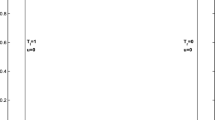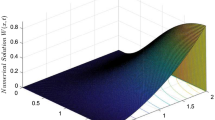Abstract
This paper concerns an efficient finite element method for the natural convection equations with the scalar auxiliary variable approach. The linearly extrapolated Crank-Nicolson techniques are used to discretize nonlinear terms in the Navier–Stokes equations and the heat equation. The induced scalar auxiliary equation is an univariate ordinary equation. With the benefit of the new defined system, the redefined stability of the proposed method is obtained under the fully explicit scheme for the nonlinear terms without the requirement of skew-symmetric trilinear forms. The optimal convergence rates in space for all the variables are proved. The second order convergence rates in time are also obtained. Finally, numerical experiments are provided to support the theoretical analysis and demonstrate the efficiency of the proposed scheme.





Similar content being viewed by others
Availability of Data and Material
Data available on request from the authors.
References
Adams, R.A.: Sobolev spaces. Pure and Applied Mathematics, Vol. 65, Academic Press [Harcourt Brace Jovanovich, Publishers], New York-London (1975)
BaïRi, A., Zarco-Pernia, E., de María, J.M.G.: A review on natural convection in enclosures for engineering applications the particular case of the parallelogrammic diode cavity. Appl. Therm. Eng. 63(1), 304–322 (2014)
Boland, J., Layton, W.: An analysis of the finite element method for natural convection problems. Numer Methods Partial Differ. Equ. 6(2), 115–126 (1990). https://doi.org/10.1002/num.1690060202
Busto, S., Tavelli, M., Boscheri, W., Dumbser, M.: Efficient high order accurate staggered semi-implicit discontinuous Galerkin methods for natural convection problems. Comput. Fluids 198(104399), 28 (2020). https://doi.org/10.1016/j.compfluid.2019.104399
Cao, C., Titi, E.S.: Global well-posedness of the three-dimensional viscous primitive equations of large scale ocean and atmosphere dynamics. Ann. Math. (2) 166(1), 245–267 (2007). https://doi.org/10.4007/annals.2007.166.245
Gebhart, Benjamin: The 1978 freeman scholar lecture: Buoyancy induced fluid motions characteristic of applications in technology. J. Fluids Eng. 101(1), 5 (1979)
He, Q., Shi, X.: Energy stable discontinuous Galerkin method for compressible Navier-Stokes-Allen-Cahn system. Commun. Nonlinear Sci. Numer. Simul. 98, 105771 (2021). https://doi.org/10.1016/j.cnsns.2021.105771
He, Y., Lin, Y., Sun, W.: Stabilized finite element method for the non-stationary Navier-Stokes problem. Discrete Contin Dyn Syst Ser B 6(1), 41–68 (2006). https://doi.org/10.3934/dcdsb.2006.6.41
Heywood, J.G., Rannacher, R.: Finite element approximation of the nonstationary Navier-Stokes problem. I. Regularity of solutions and second-order error estimates for spatial discretization. SIAM J. Numer. Anal. 19(2), 275–311 (1982). https://doi.org/10.1137/0719018
Heywood, J.G., Rannacher, R.: Finite-element approximation of the nonstationary Navier-Stokes problem. IV. Error analysis for second-order time discretization. SIAM J. Numer. Anal. 27(2), 353–384 (1990). https://doi.org/10.1137/0727022
Hou, Y., Yan, W., Jing, F.: Numerical analysis of the unconditionally stable discontinuous Galerkin schemes for the nonstationary conduction-convection problem. Comput. Math. Appl. 80(6), 1479–1499 (2020). https://doi.org/10.1016/j.camwa.2020.07.008
Huang, F., Shen, J., Yang, Z.: A highly efficient and accurate new scalar auxiliary variable approach for gradient flows. SIAM J. Sci. Comput. 42(4), A2514–A2536 (2020). https://doi.org/10.1137/19M1298627
Jiji, L.M.: Heat convection. Springer Berlin Heidelberg (2009) https://doi.org/10.1007/978-3-642-02971-4
Li, X., Shen, J.: Error analysis of the SAV-MAC scheme for the Navier-Stokes equations. SIAM J. Numer. Anal. 58(5), 2465–2491 (2020). https://doi.org/10.1137/19M1288267
Li, X., Shen, J.: On a SAV-MAC scheme for the Cahn-Hilliard-Navier-Stokes phase-field model and its error analysis for the corresponding Cahn-Hilliard-Stokes case. Math. Models Methods Appl. Sci. 30(12), 2263–2297 (2020). https://doi.org/10.1142/S0218202520500438
Lin, L., Yang, Z., Dong, S.: Numerical approximation of incompressible Navier-Stokes equations based on an auxiliary energy variable. J. Comput. Phys. 388, 1–22 (2019). https://doi.org/10.1016/j.jcp.2019.03.012
Liu, Q., Shi, D.: New error analysis of a second order BDF scheme for unsteady natural convection problem. Appl. Numer. Math. 154, 243–259 (2020). https://doi.org/10.1016/j.apnum.2020.04.004
Nochetto, R.H., Pyo, J.H.: The gauge-uzawa finite element method part ii: The boussinesq equations. Math. Models Methods Appl. Sci. 16(10), 1599–1626 (2008)
Pan, X., Kim, K., Lee, C., Choi, J.I.: Fully decoupled monolithic projection method for natural convection problems. J. Comput. Phys. 334, 582–606 (2017). https://doi.org/10.1016/j.jcp.2017.01.022
Patel, S.S., Min, M., Uga, K.C., Lee, T.: A spectral-element discontinuous galerkin lattice boltzmann method for simulating natural convection heat transfer in a horizontal concentric annulus. Comput. Fluids 95, 197–209 (2014)
Qian, Y., Zhang, T.: On error estimates of the projection method for the time-dependent natural convection problem: first order scheme. Comput. Math. Appl. 72(5), 1444–1465 (2016). https://doi.org/10.1016/j.camwa.2016.07.013
Scott, R.: Optimal \(L^{\infty }\) estimates for the finite element method on irregular meshes. Math. Comp. 30(136), 681–697 (1976). https://doi.org/10.2307/2005390
Shen, J., Xu, J.: Convergence and error analysis for the scalar auxiliary variable (SAV) schemes to gradient flows. SIAM J. Numer. Anal. 56(5), 2895–2912 (2018). https://doi.org/10.1137/17M1159968
Shen, J., Xu, J., Yang, J.: The scalar auxiliary variable (SAV) approach for gradient flows. J. Comput. Phys. 353, 407–416 (2018). https://doi.org/10.1016/j.jcp.2017.10.021
Shen, J., Xu, J., Yang, J.: A new class of efficient and robust energy stable schemes for gradient flows. SIAM Rev. 61(3), 474–506 (2019). https://doi.org/10.1137/17M1150153
Su, H., Qian, L., Gui, D., Feng, X.: Second order fully discrete and divergence free conserving scheme for time-dependent conduction-convection equations. Int. Commun. Heat Mass Transfer 59, 120–129 (2014)
Tang, L.Q., Tsang, T.T.H.: A least-squares finite element method for time-dependent incompressible flows with thermal convection. Int. J. Numer. Meth. Fluids 17(4), 271–289 (1993)
Temam, R.: Navier-Stokes equations. Theory and numerical analysis. Studies in Mathematics and its Applications, Vol. 2, North-Holland Publishing Co., Amsterdam-New York-Oxford (1977)
Temam, R.: Infinite-dimensional dynamical systems in mechanics and physics, Applied Mathematical Sciences, vol. 68, 2nd edn. Springer-Verlag, New York, (1997) https://doi.org/10.1007/978-1-4612-0645-3
Thomée, V.: Galerkin Finite Element Methods for Parabolic Problems, Springer Series in Computational Mathematics, vol. 25, 2nd edn. Springer-Verlag, Berlin (2006)
Wang, M., Huang, Q., Wang, C.: A second order accurate scalar auxiliary variable (SAV) numerical method for the square phase field crystal equation. J Sci Comput 88(2), 33, 36 (2021). https://doi.org/10.1007/s10915-021-01487-y
Wanschura, M., Kuhlmann, H., Rath, H.: Three-dimensional instability of axisymmetric buoyant convection in cylinders heated from below. J. Fluid Mech. 326, 399–415 (1996)
Yang, J., Liang, H., Zhang, T.: The Crank-Nicolson/explicit scheme for the natural convection equations with nonsmooth initial data. Adv. Appl. Math. Mech. 12(6), 1481–1519 (2020). https://doi.org/10.4208/aamm.oa-2019-0206
Yang, X., Ju, L.: Linear and unconditionally energy stable schemes for the binary fluid-surfactant phase field model. Comput Methods Appl Mech Engrg 318, 1005–1029 (2017). https://doi.org/10.1016/j.cma.2017.02.011
Zhao, J., Wang, Q., Yang, X.: Numerical approximations for a phase field dendritic crystal growth model based on the invariant energy quadratization approach. Internat J Numer Methods Engrg 110(3), 279–300 (2017). https://doi.org/10.1002/nme.5372
Acknowledgements
This work was partially supported by the Science Challenge Project (No. TZ2018001), the National Natural Science Foundation of China (Nos. 12071261, 11831010, 11871068 and 12001325), the National Key R &D Program of China (No. 2018YFA0703900) and the State Key Program of National Natural Science Foundation of China Grant No. 12131014.
Funding
The authors have not disclosed any funding.
Author information
Authors and Affiliations
Corresponding author
Ethics declarations
Conflict of interest
The authors declare that they have no conflict of interest.
Additional information
Publisher's Note
Springer Nature remains neutral with regard to jurisdictional claims in published maps and institutional affiliations.
Rights and permissions
Springer Nature or its licensor holds exclusive rights to this article under a publishing agreement with the author(s) or other rightsholder(s); author self-archiving of the accepted manuscript version of this article is solely governed by the terms of such publishing agreement and applicable law.
About this article
Cite this article
Li, Y., Zhao, W. & Zhao, W. Optimal Convergence of the Scalar Auxiliary Variable Finite Element Method for the Natural Convection Equations. J Sci Comput 93, 39 (2022). https://doi.org/10.1007/s10915-022-01981-x
Received:
Revised:
Accepted:
Published:
DOI: https://doi.org/10.1007/s10915-022-01981-x
Keywords
- Natural convection equations
- Linearly extrapolated Crank–Nicolson method
- Scalar auxiliary variable approach
- Error estimates




